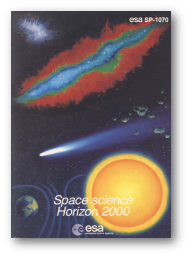ESA Science & Technology - Publication Archive
Publication archive
Publication archive
Pages: 419
Publisher: Biblioteca della Edizioni Scientifiche e Tecniche Mondadori
ISSN: 0303-2752
(Italian)
Publisher: Biblioteca della Edizioni Scientifiche e Tecniche Mondadori
ISSN: 0303-2752
(Italian)
Published: 01 January 1986
Pages: 133
Publisher: Walker and Company
ISBN: 0-8027-0855-2
Publisher: Walker and Company
ISBN: 0-8027-0855-2
Published: 01 January 1985

Editor: Norman Longdon
Scientific Coordinator for ESA SP-1070: Henk Olthof
This report presents the outline of a long term plan for the disciplines of space science falling within the terms of reference of the ESA Directorate of Science. The study, which led to the long term plan proposed in this document, was initiated by the Director of the Scientific Programme in September 1983 and was coordinated by a Survey Committee composed of scientists from different areas of fundamental science.
Contents:
- Foreword – R.-M. Bonnet, Director of the Scientific Programme
- Introduction – J. Bleeker, Chairman of the Survey Committee
- Part 1 – A Long Term Programme for European Space Science
- Part 2 – Solar System Science
- Part 3 – Space Astronomy
- Part 4 – Mission Trends and Industrial Benefits
- Annex I – Responses to Call for Mission Concepts
- Annex II – List of Contributors
Published: 01 December 1984
In the present derivation of the radial distribution of high energy gamma-ray emissivity in the outer Milky Way, the kinematics of H I are used to construct column-density maps in various galactocentric distance ranges that are then used in combination with COS-B spacecraft gamma-ray data to determine emissivities in these distance ranges. The results obtained imply a hardening of the gamma-ray spectrum with increasing distance, and include an energy-dependent decrease that is interpreted as a steep gradient in the cosmic-ray electron density and a near constancy of the nuclear component. The galactic origin of electrons with energies of up to several hundreds of MeVs is confirmed.
Published: 16 June 1984
Pulsed gamma-ray emission from radio pulsars has been sought in a study of pulsar parameters for 145 radio observations, contemporary with gamma-ray observations, by the COS-B spacecraft. No signal has been detected in the 50 MeV-2 GeV energy range of the study, either globally or from individual pulsars. These results indicate that the average product of the conversion efficiency from the pulsar braking power into gamma-rays, and the pulsar moment of inertia, cannot exceed 6 x 1043 g cm², for pulsar ages greater than 40,000 years. This implies that the contribution of old pulsars to the observed galactic gamma-ray emission is less than 5 percent for gamma-ray energies greater than 50 MeV.
Published: 15 November 1983
A search through COS-B data for gamma-radiation from a number of extragalactic objects reveals no strong evidence for any positive identification except, as already reported, for the region around the quasar 3C273. Upper limits to the photon fluxes from active extragalactic objects are evaluated using a likelihood method. They reinforce the conclusion reached by Bignami et al. (1979) from the SAS-2 data that the flux upper limits lie substantially below the extrapolation of spectra measured at X-ray energies. The proposed identifications of 2CG135+01 are also discussed
Published: 15 January 1981
The results of a second observation in the Virgo region by the ESA COS-B satellite are presented. The presence of a high-energy (50-800 MeV) Gamma-radiation source is confirmed, and its position is consistent with 3C273. The error box at the 90% confidence level containing the quasar is ~2.5 square degrees and the probability of a change coincidence of the gamma-ray source with 3C273 is approximately 10-3. No variation of the gamma-ray fluxes between the two observations in July 1976 and June 1978 is observed within the ~50% uncertainty. Spectral y-ray data for the total 3C273 data set are presented and compared with low and high-energy X-ray contemporary measurements. Recent Einstein Observatory X-ray data on the short term variability of the central part of the QSO are used to show that, within reasonable assumptions, the photon-photon interaction excludes the gamma-ray source from coinciding with the variable X-ray source, thus ruling out comptonisation models for the production of energetic photons.
Published: 15 January 1981
The recently proposed nearby (distance approximately 0.03 pc) cloud of Vidal-Madjar et al. (1978) has an angular extent encompassing the Rho Oph region and the COS-B CG 353+16 source. In an attempt to analyze a possible association between the gamma-ray source and the cloud, usage is made of SAS-3 low energy X-ray data to put an upper limit on the columnar density, and thus such an association can easily be excluded. Furthermore, the possibility is analyzed that the COS-B source is associated with the Rho Oph dark cloud complex, and that the responsible process is the interaction of cosmic rays with the cloud mass. It is seen that a standard Black and Fazio (1973) mechanism can hardly be at work so the quantitative requirements are given for an improved gamma-ray production rate, obtainable, for instance, within the model of Forman et al. (1979).
Published: 16 July 1980
Gamma-ray observations from the COS-B satellite and radio pulse-timing measurements from the Tidbinbilla Deep Space Station are used to determine accurately the relative phases of the radio (2295 MHz) and gamma-ray (above 50 MeV) pulses from the Vela pulsar. Two independent analysis procedures are employed, and both show that the peak of the radio pulse leads the peak of the first gamma-ray pulse by 11.2 plus or minus 0.5 ms. This result, together with the data of Manchester et al. (1978), indicates that the phase delay relative to the radio pulse peak of the pulse components at optical and gamma-ray frequencies are about 11 ms (first gamma-ray), 21 ms (first optical), 42 ms (second optical), and 49 ms (second gamma-ray).
Published: 16 September 1978
The decrease of brightness temperature of relic radiation in the direction of the cluster of galaxies identically testifies to the existence of hot intergalactic gas in clusters.
Published: 01 November 1972
—
20 Items per Page
